Essay by Maja Trochimczyk
History
The modern Polish-American favourite dance, the polka is a lively couple-dance in a moderately fast duple meter. Because of its acceptance as a ethnic symbol by Polish immigrants to North America, the polka is gradually increasing its position among Polish dances and is often present in the repertoire of Polish folk dance ensembles in the U.S. The dance, however, is not Polish; it is not enumerated among the five “national” dances of Poland which include: polonaise, kujawiak, mazur, oberek, and krakowiak.
According to the New Grove Dictionary of Music and Musicians, the polka originated in Bohemia around 1830 as a round-dance, and became popular throughout Europe and in America in the course of the 19th century. The name “polka” is derived from Czech words for “field” or “half;” in other interpretations the name relates to the Czech term for a Polish girl, “polska,” in reference to the krakowiak dance-songs which the Bohemians adopted for their polkas. It is interesting to note that the word “Polka” means “Polish woman” in Polish.
Music with the polka’s characteristics appears in various collections written about 1800 for practical use by village musicians. In the 19th century polkas were composed by the leading composers of ballroom music of the 19th century (including both Johann Strausses); examples occur in art music by Smetana, Dvorak, and others. In the following years polka was performed in many countries all over the world such as Austria, France, England, USA and India. It attained extraordinary popularity, so much so that clothes, hats, streets and even dishes were named after it (e.g. “polka dots”).
Magazines and newspapers of the time were full of news items, descriptions, illustrations and advertisements referring to the dance. In the early days of polka’s triumphant round-the-world tour the polka was accompanied by related Bohemian dances (trasak, skocna, rejdovak). However, local dancing-masters introduced their own variants. During the 1840s the polka-mazurka, which combined polka steps with the 3/4 time of the mazurka, was popular. It found its way to the U.S. in mid 1860s.

The modern American polka is distant from its European roots. Charles Keil lists six different polka styles, some of which have intermingled in the U.S. since the 1920s resulting in the present-day polka of the Polish American ethnic community: Slavic polkas (Polish, Slovenian), Germanic polkas (German, Czech- Bohemian), and southwestern polkas (Mexican and Papago-Pima). All the “ethnic” terms in this list should be hyphenated with “American” (e.g. Polish-American); moreover, all of the polkas “have come to define a certain persistent quality of ethnic working-class identity” (Keil 1992, 3). The distinct Polish-American version of the polka has roots in working class communities of the East Coast and the Midwest with mixed Polish, German and Czech populations. Musicians of the Eastern polka tradition included Walt Solek and Walter Dana Daniłowski. In 1950s Chicago emerged as a major center and the source of the dominant style of the polka which crystallized in the music of Li’l Wally (slower tempo, expressive lyrics and the ensemble including the clarinet, trumpet, and concertina). Polish-American polka bands are so widespread now, and the genre so well-established that there is a separate category at the Grammy Awards dedicated to the polka as well as numerous websites on the Internet (e.g. PolkaNet.com).
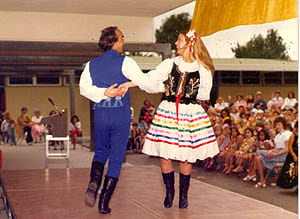
Dancing the Polka has its fans and foes. According to Keil, “Polka aficionados have cultivated a ritual sense of present time in which individual freedom of expression and maximum sociability reinforce each other. The polka dancer steps outside daily routine and everyday cares to move in complicated communion with music, a partner, and a revolving group of dancers, all at the center of a long and evolving tradition that has been sustained by generations of polka dancers in a specific community” (Keil 1992, 3).
For some members of the American Polonia the polka was a definite marker of their ethnic identity; a Wisconsin grandfather of a music student from California rejected the music of Chopin as a musical symbol of Polishness, for him only the manly, energetic and vivacious polka would truly express the “Polish spirit.” This dance, however, is not a meaningful symbol of Polish culture for Poles from Poland (Erdmans 1998, 120; Harley 2000) and has not been treated as an important element of Polish and Polish-American cultures by Polonian scholars who tend to emphasize “high-culture Polishness” symbolized by Chopin. According to Charles Keil, the Polish middle class “hates polka with a passion” (Keil 1979).
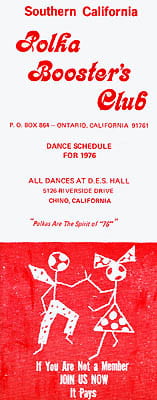
Dancing the polka is a very popular recreational activity for American Polonia in Southern California. In 1970s, the Polka Booster’s Club organized regular dances at Chino, California. A program from 1976 reproduced here contains a slogan “Polkas are the Spirit of ’76’.” Touring groups from other parts of the country have played at social dances overflowing with people; many Polish American cultural and social clubs have organized dances to local bands which feature numerous polkas in their repertoire.
The Polish Center in Riverside is the site of weekend picnics with dancing and music through the summer and even fund raising balls of the various clubs and organizations (Polish American Congress of Southern California, dance groups) feature dance bands with a repertoire of traditional favorites, polkas, waltzes, tangos (as well as an array of Latin dances and classic rock-and-roll).
However, the repertoire of polkas is notably missing from the social dancing provided for balls of the Helena Modjeska Club of Polish Arts and Culture in Los Angeles. With close links to Poland’s intelligentsia, the club emphasizes the “high-culture” aspects of Polish traditions excluding the polka from its social events (replacing it with American jazz and rock, and Latin-American salsa; Harley 2000).
Polish American press (News of Polonia, Voice of Polonia) publish advertising about the upcoming dances and post-event reports; journalist Betsy Cepelik (News of Polonia) is an expert dancer and a polka aficionado. Similarly to other Polonian radio stations, Polish Radio Ela intersperses its programming with an array of polkas. Interestingly, it is the older “ethnic” members of the Polish American community that identify with this sound; according to Mary Patrice Erdmans’s study of Chicago Polonia (Erdmans 1998, 121), the more recent immigrants consider “Polish content” of the programming more important than the inclusion of the polkas.
Description
Dziewanowska’s study includes no entry on polka as a whole, with a variety of polkas described in various regions.:
In the Łowicz region of central Mazowsze there is “polka drygana” – very popular … in the Opoczno region of Mazowze, tramblanka, in the Rzeszów region four different polkas, including “hurra” “kucana” “przez noge” “suwana”. In Lachy Słdeckie region of Małopolska (between Rzeszów and the mountains, centered on Nowy Sącz, there is polka gwóźdź, polka z nigi. in the Upper Silesia there is szpacyr polka in the Cieszyn region.
Dąbrowska’s research into dances of Mazowsze suggests the coexistence of two different polkas throughout the area: regular polka and “polka trzesiona” (i.e. drygana in Dziewanowska’s terminology). The regular polka is danced on the circle by rotating couples who never separate and continue turning around the dance space until one or several male dancers calls for a change of direction (Dąbrowska 1980, p. 176). The dance is fast paced; the basic step consists of three small steps performed in such a way that “one foot chases the other.” The dancers move smoothly and without interruptions, following the regularity of the music. In the “polka trzęsiona” the dancers are also located on the circumference of the circle and rotate simultaneously around the whole circle and their own axes (as in the regular polka and oberek). The difference stems from a different type of the step used: the very small steps of the dance consist of lifting the feet and placing it down vertically, very fast (in a regular polka the feet perform a sliding, or shuffling motion). As a result, the dancers shake throughout the dance, this shaking does not result from high jumps, but from the feet motion and is increased in accelerated tempi. (Dąbrowska 1980, 180).
Polka tramblanka or trampolka is also danced by couples rotating around the circle; the basic step of the polka in measures 1-2 is followed by small jumps on one leg in mm. 3-4 (changing legs from measure to measure). The dance has an alternating format of two measures of polka and two measures of jumps. At times, the schema includes one measure each of the basic polka step and the jump step.
As an exhibition dance, the polka includes a variety of gestures, with special steps, jumps, and kicks, lifting the women, dancing in circle, etc. The particular array of steps depends on the choreographer and the spatio-temporal image of a tradition that he/she wants to evoke (e.g. early 20th-century working-class Warsaw, 19th-century middle-class Warsaw).
Costumes
Polkas appear in the repertoire of folk ensembles of the whole Poland, including even the Podhale area of the Tatra Mountains (see zbójnicki and góralski for information about this region) from which other national dances of Poland were absent. (The current repertoire of Podhale music consists almost entirely of melodies in duple meter; perhaps the meter of the polka allowed for its preservation in this repertoire). In any case, it would be very hard to find a polka performed in the gorale costume from the Tatra mountains by any of the Polish folk dance groups in the U.s.
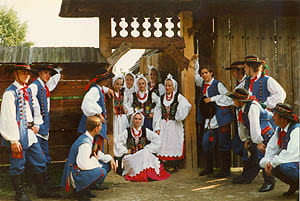
There are numerous varieties of the polka in the folklore of the Rzeszów area in south-eastern Poland. Regional costumes from this area would be appropriate for the performance of these polkas (often included in dance suites from the area). Polkas are also performed in costumes from the various areas in the Mazowsze region.
The Rzeszów costume, as presented by members of the Krakusy Ensemble, includes blue outfits with red wool buttons and trimmings for men (who wear high boots and white shirts), and colorful skirts with white aprons, white scarves wrapped around the heads, tight, dark vests with contrasting trimmings and embroidery, and coral beads for women.
However, as the image of the polka by Zofia Stryjeńska reproduced above indicates, the most common association of the polka is with urban folklore. Stryjenska’s dancers are working-class city dwellers in their fashionable Sunday clothes: a revealing, somewhat vulgar dress for the woman, and an exaggerated checkered suit for the man.
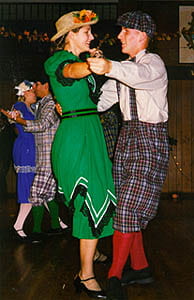
The couple depicted in the Stryjeńska woodcut could be a housemaid or a cook and her beau (a factory worker) enjoying their dance on their weekend date. This aspect of the polka connects it with the lower class, urban folklore of big cities, particularly of Warsaw.
The connection of the polka to the early 20th-century Warsaw proletariat (or even lumpen-proletariat of small-time crooks and easy women) was articulated in the suite of dances from Old Warsaw by the Krakusy Folk Dance Ensemble (performance in 1997).
Notice the outrageously mismatched colors and accessories: straw hats with flowers for the woman and the oversized checkered hat and pants worn by the man in the Krakusy polka.
The dances from Old Warsaw performed by the adult Krakusy group highlighted the urban image of the polka presented by Stryjeńska. Their dance included a variety of somewhat vulgar gestures and broadly exaggerated dance positions. The women jumped and turned, showing their undergarments and screaming with excitement. The gestures and costumes were markers of the urban lower class character of the dance.
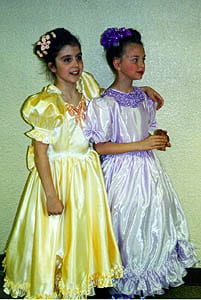
A set of 19th-century Warsaw songs and dances presented by the junior group of the Podhale Polish Folk Dance Company at the Paderewski Festival in Paso Robles in 1999 articulated a somewhat higher social standing of the polka dancers. The girls wore elegant evening gowns (somewhat fanciful, each in a different pastel color matched by the flowers in the hair), the boys were all decked out in black coattails, white shirts, and bow ties (see the image in the History section of this entry).
The clothes and gestures were designed to be charming, with a slightly amusing air of pretentious elegance – perhaps, of children from the middle-class dressed up for an evening out on town, their first social event… The costumes were not specific to a particular decade of the 19th-century or a localized fashion yet helped to create an image of a “bygone era.”
Music
The 19th-century polka was characterized by a frequent occurrence of a rhythmic motive consisting of two sixteenths followed by an eightnote:
At that time the tempo of the polka was that of military march played rather slowly, at 52 bars (MM=104) per minute. The music was usually in ternary form with eight-bar sections, sometimes with a brief introduction and a coda. Such polkas were cultivated by all the leading ballroom dance composers of the latter part of the 19th century.

In Polish folklore collected by Oskar Kolberg in the second half of the 19th century, the polkas appear in the music of many regions; usually they are grouped with other, more numerous dances in duple meter (e.g. krakowiak, szot, kozak).
The example comes from the area of Warsaw, it is no. 727 from the second volume of Kolberg’s Mazowsze (published in 1886; reprinted in Complete Works as vol. 25, 1963).
Among contemporary popular and ethnic dance genres, the polka has kept its image of the working-class dance providing enjoyment and relaxation after long days of hard, physical labor. With the “polka happiness” providing the keyword to its meaning (term borrowed from the title of a 1992 study by Charles and Angeliki Keil), the dance is slowly gaining popularity as a recreational activity for amateur dancers who relish the polka’s lively tempo and enjoy the strenuous exercise that it provides. The musical styles continue to evolve and the Polish-American polka remains one of the few dances historically linked to Poland which are alive in social practice. The krakowiaks, mazurs or zbójnickis are exhibition dances performed by semi-professional Polish folk dance ensembles for Polish and American audiences. The polonaise kept its function as a high-status musical symbol of Polishness (and its name appears in several balls of Polish-American cultural organizations). Only the polka is danced by everyone.
Sources of Materials
- Dąbrowska, Grażyna. Taniec ludowy na Mazowszu [Folk dance in Mazovia]. Kraków: PWM Edition, 1980.
- Dziewanowska, Ada. Polish Folk Dances & Songs: A Step by Step Guide. New York: Hippocrene Books, 1999.
- Erdmans, Mary Patrice. Opposite Poles. Immigrants and Ethnics in Polish Chicago 1976-1990. University Park, Penn.: The Pennsylvania State University Press, 1998.
- Harley, Maria Anna. “Dance as a National Symbol: Polish Dance in Southern California” Project for Southern California Studies Center at USC, August 2000.
- Janta, Aleksander. A History of Nineteenth Century American-Polish Music New York: The Kosciuszko Foundation, 1982.
- Keil Charles. “Class and Ethnicity in Polish America,” Journal of Ethnic Studies 7 no. 2 (1979): 37-46.
- Keil Charles and Angeliki V. Keil. Polka Happiness. Philadelphia: Temple University Press, 1992.
- Kolberg, Oskar: Mazowsze II , vol. 25 of Dzieła Wszystkie (Complete Works). Wrocław-Poznań: Polskie Towarzystwo Ludoznawcze, 1963. Reprint of a 1886 publication.
- “Polka,” entry in Encyklopedia Muzyki PWN Warszawa: PWN, 1994.
- “Polka,” entry in the New Grove Dictionary of Music and Musicians, vol. 15. Stanley Sadie, ed. London: McMillan, 1980.
Illustrations from Polish folk art (straw cutouts); Zofia Stryjeńska’s 1927 “Polka” image; photographs from PMRC Collection and from archival material gathered for M.A. Harley’s Polish Dance in Southern California project.


